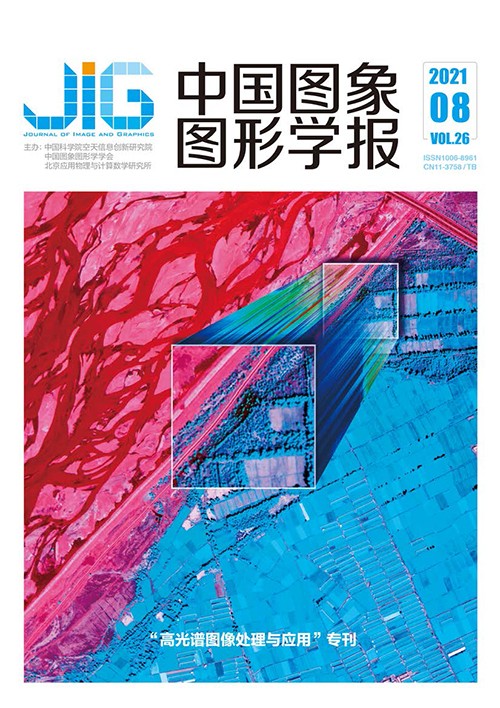
低成本便携式多光谱成像系统的研发及优化
摘 要
目的 针对现有多光谱成像系统存在成本高、结构复杂、操作难度大和响应速度慢等问题。因此,本文提出了一种基于脉冲调制的低成本便携式多光谱成像系统,并采用客观图像质量评估(image quality assessment,IQA)的方法对其系统参数进行优化。方法 该系统主要由光源模块、控制模块、图像采集模块和图像分析模块4部分组成。光源模块采用9个波长的LED (light emitting diode)阵列,其中心波长为365 nm、390 nm、460 nm、515 nm、585 nm、620 nm、650 nm、730 nm和840 nm;控制模块主要包括LED驱动电路和USB (universal serial bus)电源,可以通过发送一定时间间隔的脉冲波来分时点亮LED,并通过一定阻抗匹配使LED发光强度达到最大值;图像采集模块主要使用去除红外截止滤波片的高清红外工业相机,该相机的最佳光谱感应范围包含所选的9个LED灯珠的中心波长;图像分析模块主要执行客观图像质量评估算法。系统执行时,STC89C51单片机发射周期为T的脉冲波来驱动9种不同波长的LED分时点亮。然后,计算机平台调用高清红外相机模组,以相匹配的间隔捕获多光谱图像。在系统拍摄参数优化实验中,本文采用模糊度和清晰度评价指标对所获得的多光谱图像从相机拍摄时间间隔、相机拍摄距离和光照强度3个角度进行质量评估,进而获得较优的系统成像参数。结果 通过改变系统拍摄参数,对3个场景下的不同拍摄条件所获取的多光谱图像质量进行评估,结果显示:对于本文所搭建的多光谱成像系统,相机拍摄时间间隔与LED灯珠频闪周期同步,拍摄距离为25 mm,光照强度为45 Lux下成像质量相对较好。结论 本文设计并搭建的基于脉冲调制的低成本便携式多光谱成像系统成本低、操作难度小、结构简单、成像质量较好、成像速度较快,可以满足多光谱成像系统大规模推广使用的要求。此外,本文的系统设计方法、设计思路和实验方案等可以为后续研究提供借鉴。
关键词
Development and optimization of a low-cost and portable multispectral imaging system
Zhu Haonan, Hu Menghan, Zhang Jian, Li Qingli(Shanghai Key Laboratory of Multidimensional Information Processing, East China Normal University, Shanghai 200241, China) Abstract
Objective Hyperspectral imaging systems are widely used in various fields owing to their image-spectral characteristic and unique "spectral fingerprint" information. Multispectral imaging systems are generally less costly and more suitable for the large-scale applications compared with hyperspectral imaging systems. Nonetheless, the existing multispectral imaging systems suffer from certain problems, such as high cost, complex structure, difficult operation, and slow response time. Accordingly, a low-cost portable multispectral imaging system based on pulse modulation is proposed in this study, and its imaging parameters are optimized using the objective image quality assessment methods. Method This system strives for a high degree of integration in a hardware design. The light source and control central processing unit(CPU) are integrated on a small printed circuit board(PCB). The 18 light emitting diode(LED) pairs of nine different wavelengths are integrated on a circular PCB board to form a circle by using a disc design. The light source can be converged, and the brightness can be improved to a certain extent. The proposed multispectral imaging system is mainly composed of a light source, a control, an image acquisition section, and an image analysis part. The light source part mainly includes nine LED arrays with the center wavelengths of 365 nm, 390 nm, 460 nm, 515 nm, 585 nm, 620 nm, 650 nm, 730 nm, and 840 nm. The control part mainly includes the self-designed LED driver circuit and universal serial bus(USB) power supply, which can light up LED arrays by sending the pulse waves at certain time intervals in time and allows the LED arrays to reach the maximum luminous intensity through the certain impedance matching. The image acquisition part primarily consists of a high-definition infrared industrial camera without the near infrared(IR) cut-off filter, which has an optimal spectral sensing range encompassing the central wavelengths of the selected nine LED arrays. The computer is used to call OpenCV through the Python language to control the camera to take images at a certain frequency. The image analysis part mainly performs the objective image quality assessment algorithms. When the system is executed, the STC89C51 microcontroller emits a pulse wave with a period of T (T is adjustable) to drive nine different wavelengths of LED arrays to light up in time. Subsequently, the computer platform calls the camera modules to capture multispectral images at matching intervals. In the system optimization experiments, we use the sharpness and the blur metrics to objectively evaluate the quality of the obtained multispectral images from three perspectives of camera shooting interval, imaging distance, and light intensity, thus obtaining better system imaging parameters. Result The quality of multispectral images acquired from various shooting parameters and shooting conditions under three different scenarios are evaluated. Results show that the image quality of the developed multispectral imaging system is relatively good under the camera shooting interval synchronized with the bead strobe cycle of the LED arrays. The imaging distance is 25 mm, and the light intensity is 45 Lux. Conclusion The developed multispectral imaging system based on pulse modulation is low-cost, less difficult to operate, has a simple structure, has better imaging quality, has faster imaging speed, and can meet the requirements of large-scale promotion of multispectral imaging systems for various application domains. In addition, the system design methods, design ideas, and experimental protocols covered in the current work may provide references for the subsequent studies.
Keywords
pulse modulation multispectral imaging image quality assessment experimental design optimization embedded systems image processing
|



 中国图象图形学报 │ 京ICP备05080539号-4 │ 本系统由
中国图象图形学报 │ 京ICP备05080539号-4 │ 本系统由